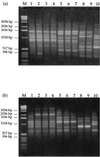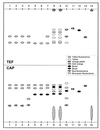Molecular identification of species from the Penicillium roqueforti group associated with spoiled animal feed
- PMID: 10742236
- PMCID: PMC92017
- DOI: 10.1128/AEM.66.4.1523-1526.2000
Molecular identification of species from the Penicillium roqueforti group associated with spoiled animal feed
Abstract
The Penicillium roqueforti group has recently been split into three species, P. roqueforti, Penicillium carneum, and Penicillium paneum, on the basis of differences in ribosomal DNA sequences and secondary metabolite profiles. We reevaluated the taxonomic identity of 52 livestock feed isolates from Sweden, previously identified by morphology as P. roqueforti, by comparing the sequences of the ribosomal internal transcribed spacer region. Identities were confirmed with random amplified polymorphic DNA analysis and secondary metabolite profiles. Of these isolates, 48 were P. roqueforti, 2 were P. paneum, and 2 were Penicillium expansum. No P. carneum isolates were found. The three species produce different mycotoxins, but no obvious relationship between mold and animal disease was detected, based on medical records. P. roqueforti appears to dominate in silage, but the ecological and toxicological importance of P. carneum and P. paneum as feed spoilage fungi is not clear. This is the first report of P. expansum in silage.
Figures


References
-
- Auerbach H, Oldenburg E, Weissbach F. Incidence of Penicillium roqueforti and roquefortine C in silages. J Sci Food Agr. 1998;76:565–572.
-
- Boysen M, Skouboe P, Frisvad J, Rossen L. Reclassification of the Penicillium roqueforti group into three species on the basis of molecular genetic and biochemical profiles. Microbiology. 1996;142:541–549. - PubMed
-
- Bruns T D, White T J, Taylor J W. Fungal molecular systematics. Annu Rev Ecol Syst. 1991;22:525–564.
-
- Coffey M T, Hagler W M, Jones E E, Cullen J M. Interactive effects of multiple mycotoxin contamination of swine diets. In: Llewellyn G C, O'Rear C E, editors. Biodeterioration research. Vol. 3. New York, N.Y: Plenum Press; 1990. pp. 117–128.
-
- Cole R J, Cox R H. Handbook of toxic fungal metabolites. New York, N.Y: Academic Press; 1981.
Publication types
MeSH terms
Substances
LinkOut - more resources
Full Text Sources

